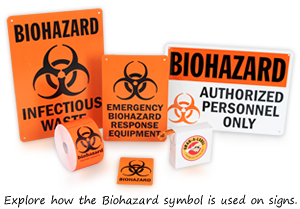
The Biohazard symbol has a rich and fascinating history behind its creation. While it seems abstract at first glance, both biologists and laymen quickly and easily grasp its warning. Only fifty years ago, the symbol was entirely unknown, but today we see the biohazard symbol in clinics,
labs, and even on skateboards! This now-ubiquitous symbol was created with some thorough testing and decision making by scientists and psychologists over 40 years ago.
In 1966, it became clear to scientist Charles L. Baldwin that biology laboratories lacked a proper symbol to mark the hazardous materials they used so frequently. In an article written by Baldwin and Robert S. Runkle called, Biohazards Symbol: Development of a Biological Hazards Warning Signal, they describe this particular problem: “In biology laboratories...a number of different symbols are in use; none of these has been
universally accepted, and did not imply or encompass all possible biohazards.” This was a danger to the entire biological studies
community and everyone else, since the lack of a universal symbol could cause dangerous confusion in the sciences. Containment facilities were beginning the process of keeping the workers safe,
but preventable, accidental infections of numerous laboratory personnel twenty years
proved an urgent need for a universal symbol. Baldwin decided to create an original, universal warning sign that everyone would soon recognize.
During his time at the Dow Chemical Company, Baldwin began to work on ideas for the new
symbol. Instead of consulting his own colleagues, he went to the Dow Marketing and Package Design department. The process began and Baldwin started to narrow down ideas. In the article that he wrote
with Robert S. Runkle, he elaborates on how he tried to think of such a symbol. Six criteria were established to address the "psychology of recognition and retention." Baldwin states that the symbol must be:
(i) striking in form in order to draw immediate attention;
(ii) unique and unambiguous, in order not to be confused with symbols used for other purposes;
(iii) quickly recognizable and easily recalled;
(iv) easily stenciled;
(v) symmetrical, in order to appear identical from all angles of approach; and
(vi) acceptable to groups of varying ethnic backgrounds.
After selecting six symbols from over forty ideas, they began a field test to see which one had the biggest impact on the general population. The testing process were based mass-psychology tests used in marketing and package design. In his article written with John Cook, he describes this process:
We tested the sample symbols across the country...there were half a dozen of our original symbols in this survey of 24 different symbols. The rest were recognizable, like the peanut man for Planter's peanuts, the Texaco star, the Shell Oil symbol, the Red Cross and the swastika. They were asked to look at them and then asked to guess at what each one meant. The biohazard symbol got the fewest guesses. Then we went back one week later to the same set of people and the same set of symbols, plus 36 more common ones, and asked them which of these did they remember the best. And they picked out the biohazard symbol.
After extensive research, Baldwin and his team produced what they believed to be the perfect warning symbol for biohazards. Its blazing orange background and perfectly symmetrical symbol stood out and avoided confusion. Its bold color and simple design made a tremendous impact on everyone who saw it. Baldwin describes the final process to publicly release the symbol in his article with John Cook:
The next major step was presenting it to the scientific community. I did that by writing a paper in the journal Science. The next was to get the authorization from the various people that would be using it. As soon as it was adopted by the Centers for Disease Control, the Occupational Safety and Health Administration and the National Institutes of Health, that's pretty good acceptance. And that was it.
This trailblazaing effort by Baldwin prompted an entire library of warnings to emerge in the scientific community. This ubiquitous symbol set the standard for unique, recognizable safety symbols that grab our attention and prevent dangerous accidents every day.

